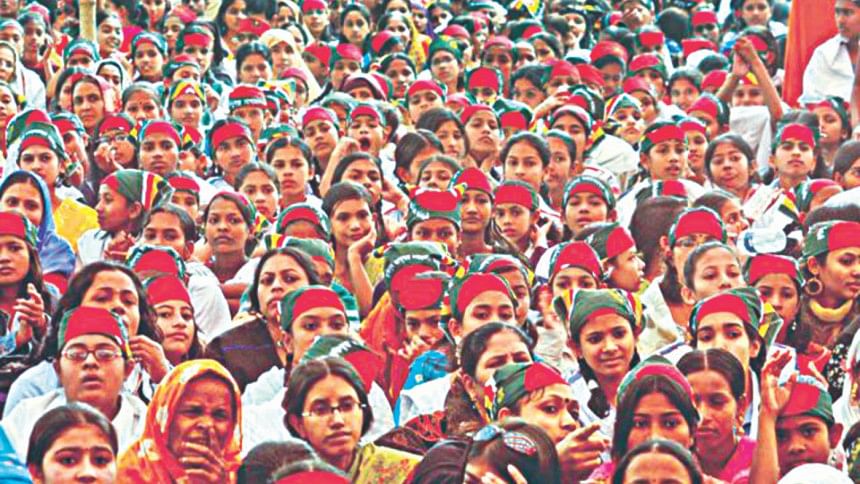Getting the best out of a youthful nation

Sakib Khan's family has six members. The parents and two sons, aged between 20 and 55 years, earn a livelihood, while the two daughters aged below 15 attend school. As most of the members earn, they can save a good amount, as well as pay taxes. The same family, after fifteen years, will have ten members, as the two sons will marry and will probably have at least two children each, and the two daughters, who were school students fifteen years back, will be married off. Mr. Sakib's two daughters-in-law will also probably be employed, but Mr and Mrs Sakib will retire as they will have crossed 65. So, the total dependent members of the family will be sixty percent, where ratios of saving and taxes to the government will drastically decline.
Bangladesh is thus passing through what is called a "demographic dividend".
Sixty-six percent of our population is aged between 15 and 64 years, and belong to the workforce. By 2030, the population of this age group would rise to 70 percent, but then it will start declining, according to the UNDP's Asia Pacific Human Development Report launched in Dhaka on April 26.
Nineteen percent of the country's population is between 15 and 24 years, which holds immense potential, but the number will decline after 2030 as is the case of the future scenario of Mr. Sakib's family. The number of people aged above 60 years in the country is now 11 million, which would be 22 million in 2030 and 44 million in 2050.
According to the Bangladesh Bureau of Statistics' latest report, only 6 lakh jobs were created in the last two years, whereas some 15-20 lakh new candidates prepare for the job market every year.
So what happens to the young men and women who remain jobless? Some five lakh (mainly men) of them go abroad every year, mainly to the oil-rich Arab countries, or to Singapore and Malaysia. But how do they fare overseas?
A common allegation regarding overseas labour migration is that they have to pay high amounts of money to finance their migration, and that a large portion of the migrants get low wages. To recoup the money that they had raised, either by selling properties or borrowing, they opt to work extra hours. Many of them leave their jobs for higher wages, but that makes their status 'undocumented'. They become more vulnerable to detention, abuse and deportation. The case of Malaysia can be cited where presently an estimated three lakh of the total six lakh Bangladeshis remain undocumented. Recent pictures circulating on social media show the young men hiding in the jungles to avoid being arrested.
Despite the risks, young people migrate abroad in flocks. The stories of Bangladeshi migrants dying in the Bay of Bengal or the Mediterranean have become commonplace. When mass graves of migrants were discovered in Thai and Malaysian borders in May last year, there was a pertinent question as to why Bangladeshis take such risky sea journeys when they are not fleeing war or persecution, as is the case with Rohingya migrants.
Why are these youths - migrating legally and illegally - so desperate? Obviously, the dearth of job opportunities at home and higher income abroad are the major push factors. The Asia Pacific Human Development report says 77 percent people earn below $3.1 a day, and 44 percent earn below $1.9, while adding that 85 percent people are in vulnerable employment.
Thus a large portion of the workforce at home are engaged in jobs that are ill-paid and menial, while the same is true for those working abroad as they do backbreaking jobs that the Arabs or the Malaysians avoid. The cities of Dubai, Abu Dhabi, Riyadh and Kuala Lumpur might not have been built had it not been for the sweat and blood of the migrant workers from Bangladesh.
Farmers, despite continuous low prices of their produce, are toiling to feed this nation; garment workers, despite 12 hours of work at minimum wage, are keeping the sector competitive; migrant workers, despite their struggle, are sending remittances to keep the balance of payments strong. Thus most of our young people, whether at home or abroad, are earning much less than what they had aspired to, or do not have any job at all.
The simple reason for this underutilisation is a lack of investment - both domestic and foreign - to create jobs. There is a mismatch between the skills acquired by the youth and the skills demanded by the market. This can be easily concluded when thousands of foreigners – Indians, Pakistanis and Sri Lankans – are found working in technical and mid-level managerial positions in Bangladesh's RMG and telecom industries, and when most Bangladeshi migrants are found at the lower tier of the job market in the Middle East, Singapore or Malaysia.
Such a scenario is actually pushing down the huge potential that this nation has. Authorities must act promptly to help young people best utilise their talents by creating jobs, providing more opportunities for developing skills and helping them become entrepreneurs. This will take the national economy to a new height by contributing to the GDP and tax revenue, giving the government the opportunity to prepare for a time when there will be more dependents as the population growth rate declines.
The writer is Senior Reporter, The Daily Star.

 For all latest news, follow The Daily Star's Google News channel.
For all latest news, follow The Daily Star's Google News channel. 







Comments